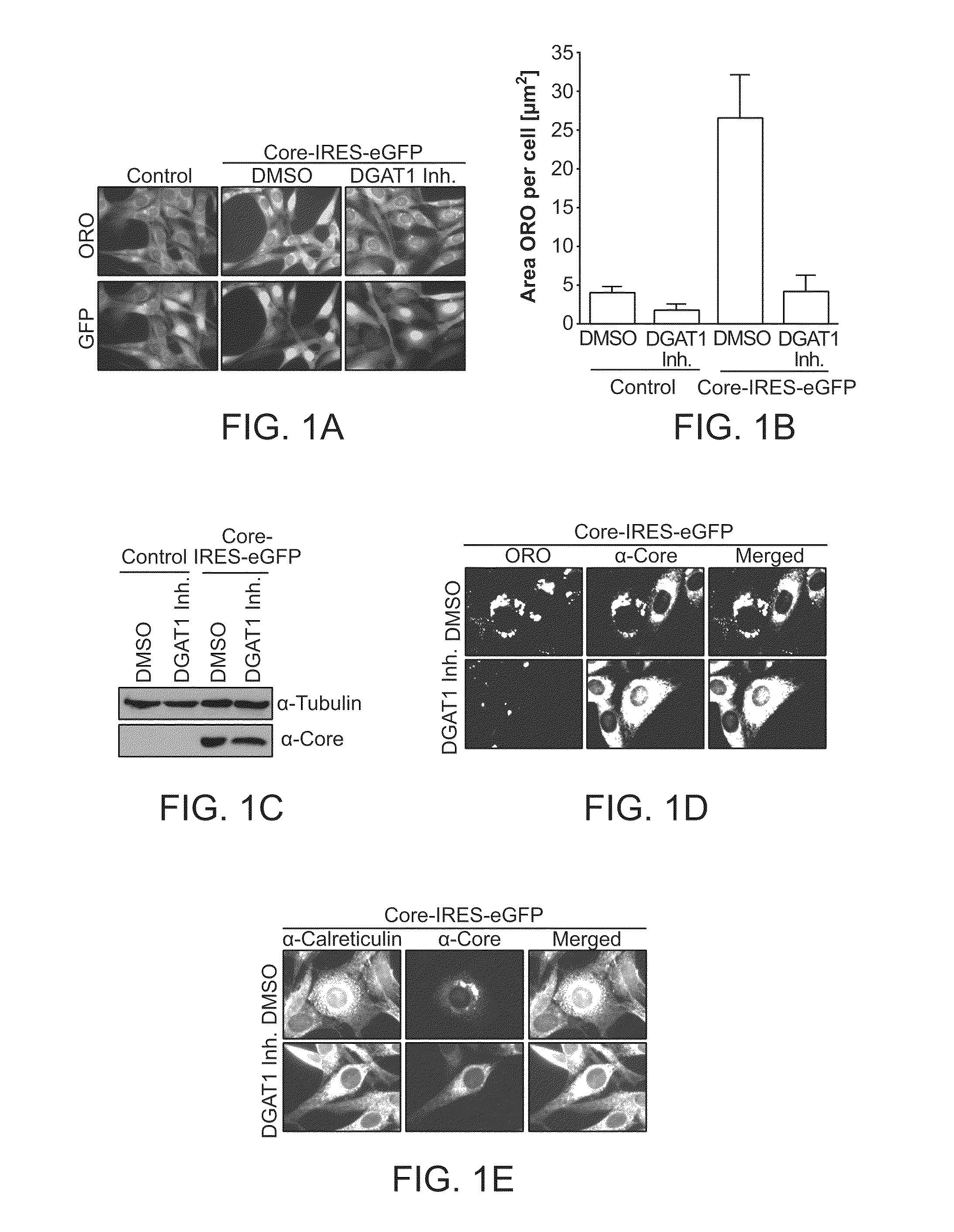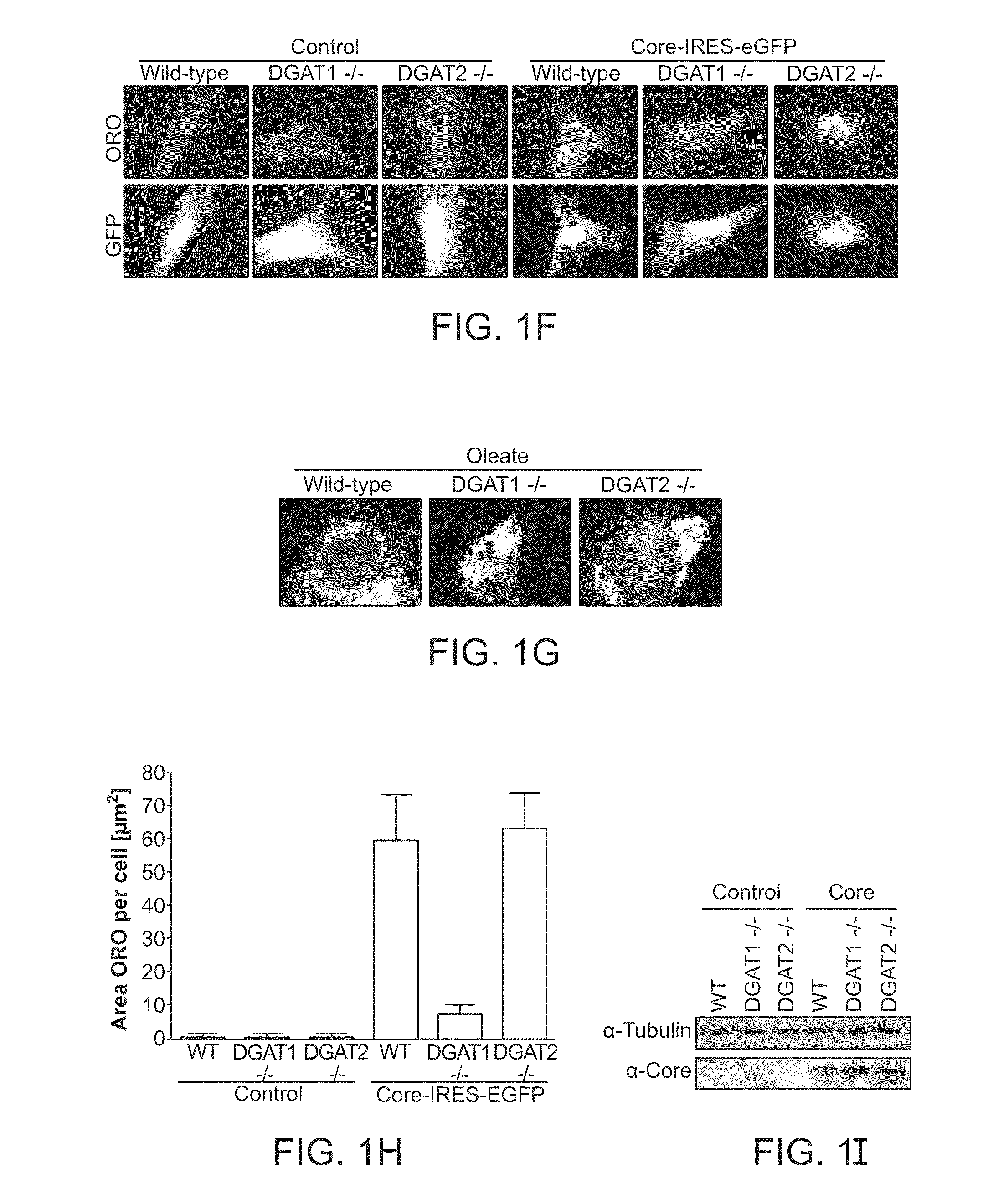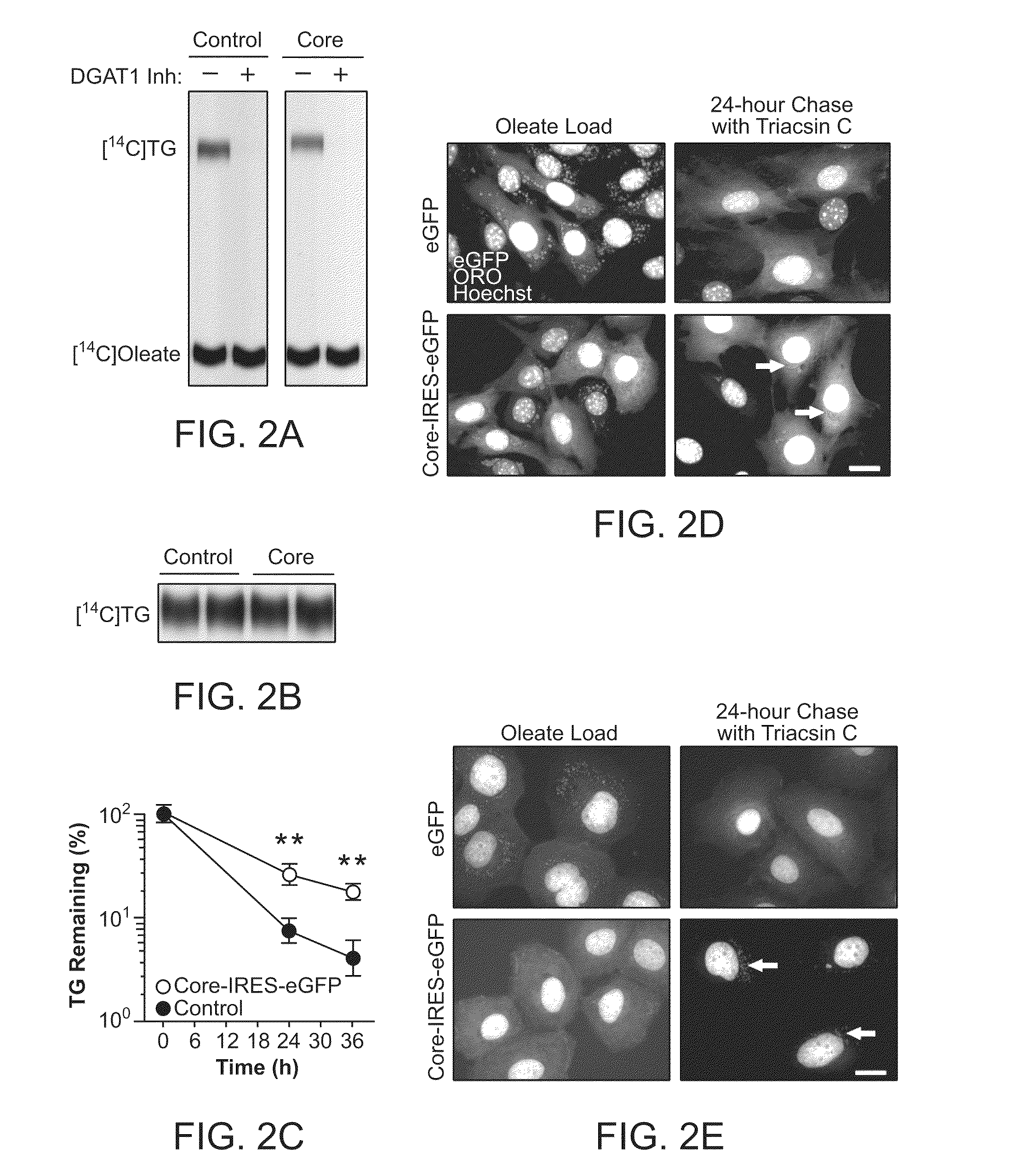Methods of treating hepatitis c virus infection
a technology of hepatitis c virus and treatment method, which is applied in the direction of biocide, antibody medical ingredients, peptide/protein ingredients, etc., can solve the problems of marked increase of the risk of hepatocellular carcinoma, patients currently have no effective treatment alternative, and advanced fibrosis or cirrhosis on liver biopsy are at significant risk of developing complications of advanced liver disease, so as to reduce the incidence of complications, reduce the time to viral clearance, and reduce viral load load
- Summary
- Abstract
- Description
- Claims
- Application Information
AI Technical Summary
Benefits of technology
Problems solved by technology
Method used
Image
Examples
example 1
Effect of DGAT1 Inhibitor on HCV Core-Induced Lipid Droplet Formation Core-Induced Lipid Droplet Accumulation Depended on DGAT1
[0211]To study Hepatitis C Virus (HCV) core-induced lipid droplet formation, the murine fibroblast cell line NIH3T3 was used, as these cells have low lipid droplet content. Upon expression of HCV core (“core”) via a lentiviral construct expressing core, NIH3T3 cells strongly accumulate lipid droplets as shown by Oil-red-O (ORO) staining. To inhibit DGAT1, a small molecule inhibitor that specifically inhibits DGAT1 activity with an IC50 of 300 nM was used. The DGAT1 inhibitor that was used has the chemical name: 2-((1s,4s)-4-(4-(4-amino-7,7-dimethyl-7H-pyrimido[4,5-b][1,4]oxazin-6-yl)phenyl)cyclohexyl)acetic acid; and the following structure:
[0212]Treatment of Core-expressing NIH3T3 cells with 20 μM DGAT1 inhibitor completely suppresses lipid droplet accumulation (FIG. 1A). Quantification of these images revealed that Core expression leads to a five fold incr...
example 2
HCV Core Expression Delays Triglyceride Breakdown
Method
[0216]The measurement of lipolysis was performed as previously described (Brasaemle et al. (2000) J. Biol. Chem. 275:38486). Cells were incubated with 400 μM bovine serum albumin (BSA)-bound oleate containing 0.125 μCi / ml of [1-14C] oleic acid (GE Healthcare, 58 mCi / mmol) for 16 h to stimulate storage of triglycerides. Cells were then washed and incubated in fresh media containing 6 μM triacsin C for indicated times and the remaining cellular triglyceride determined as above. For microscopic analysis, cells were loaded with 400 μM BSA-bound oleate for 16 h, and then incubated in fresh medium in the presence of 6 μM triacsin C, fixed in paraformaldehyde (PFA) and stained with ORO and Hoechst.
Results
[0217]It was speculated that core could stimulate triglyceride production by enhancing DGAT1 activity. However, no difference in in vitro DGAT1 activity was detected in lysates from Huh7 hepatoma cells expressing core or control cells,...
example 3
Core and DGAT2 Interact Transiently in the ER
Method
[0221]For immunoprecipitation experiments cells were lysed in lysis-buffer (150 mM NaCl, 1% NP-40 (non-ionic detergent), 1 mM ethylenediaminetetraacetic acid (EDTA), 50 mM Tris HCl, pH 7.4 and protease inhibitor cocktail (Sigma)) for 30 min and passed 10 times through a G23 needle. Clarified lysates were immunoprecipitated with antibody, specific to flagellin (FLAG) antigen and bound to agarose (α-FLAG M2 agarose) (Sigma; Bruzzard et al. (1994) BioTechniques 16:730) or DGAT1-specific antibody and protein A agarose (Invitrogen), washed 5 times in lysis buffer and resuspended in Laemmli buffer for sodium dodecyl sulfate-polyacrylamide gel electrophoresis (SDS-PAGE).
Results
[0222]To study how DGAT1 affects these core functions, co-immunoprecipitation experiments were performed. Core co-immunoprecipitated with FLAG-DGAT1, but not FLAG-DGAT2, in 293T cells (FIG. 3A) and interacted with endogenous DGAT1 in Huh7 cells (FIG. 3B). Endogenous ...
PUM
| Property | Measurement | Unit |
|---|---|---|
| prothrombin time | aaaaa | aaaaa |
| pH | aaaaa | aaaaa |
| pH | aaaaa | aaaaa |
Abstract
Description
Claims
Application Information
 Login to View More
Login to View More - R&D
- Intellectual Property
- Life Sciences
- Materials
- Tech Scout
- Unparalleled Data Quality
- Higher Quality Content
- 60% Fewer Hallucinations
Browse by: Latest US Patents, China's latest patents, Technical Efficacy Thesaurus, Application Domain, Technology Topic, Popular Technical Reports.
© 2025 PatSnap. All rights reserved.Legal|Privacy policy|Modern Slavery Act Transparency Statement|Sitemap|About US| Contact US: help@patsnap.com



